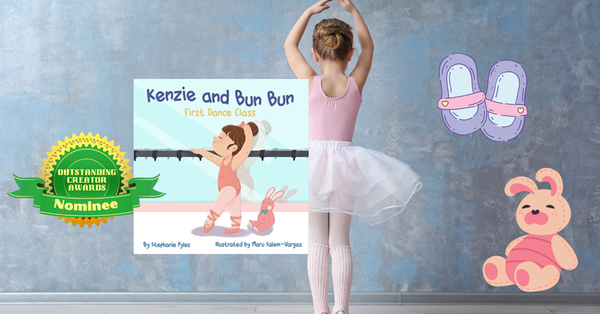|
Score: 93+/100 (9.3+ out of 10)
Kenzie and Bun Bun- First Dance Class is a cute, beautiful, and emotionally touching children's book about a little girl, her plush bunny, and her mom. In this particular book in the series, the little girl, Kenzie, looks forward to an exciting first day in dance class. Having never danced before, this new experience challenges Kenzie to step outside of her comfort zone, to try something new, and to explore a new way of expressing herself. Actually, self-expression is a major theme in this book that we'll get more into later. The other major theme of this book is just simply the love and bond that a parent and a child have for one another, and how separation can lead to worry, anxiety, and emotional distress. This is represented in more ways than one, first in exploring the loving relationship between Kenzie and her mother, and second in exploring the nurturing relationship between Kenzie and her plush bunny friend, Bun Bun. This is actually a very powerful and emotionally-charged book when you catch the subtext. This does, in fact, seem to be based on the actual, real-life experiences of the author and her daughter, who sadly passed at the age of three. That revelation in itself really helped to raise our appreciation for the book. As we saw in our previous book, Sacred Vengeance, which was inspired by the similar loss of a child, loved ones don't just pass away and disappear. They don't just vanish. Their memories and spirits stay with us. They linger with us forever, inspiring us and urging us forward. So, what seems to be a somewhat mundane story about a day in the life of a little girl takes up a totally new, fresh, and exciting tone and aura when you consider the subtext behind it. Even with all that aside, it's a beautiful book with a lot more to say. In fact, loss and coping are not ever explicitly mentioned in story itself, just in the dedication. Instead, the book actually focuses on things like being brave, trying new things, valuing/appreciating time spent with loved ones, self-expression, and—well—finding things that make you happy. It's a really fun, inspiring, and uplifting book that jams several different sub-plots into just 33 pages. It's quite an accomplishment! So that also means that this isn't a book that focuses exclusively on one thing, in fact it jumps around a bit. If you're going into this book thinking it's going to be a children's dance book like in the Once Upon a Dance series, you might be a little surprised (though probably not disappointed). It would be hard to be disappointed with a children's book with this much heart and soul. Let's talk about one of the beautiful little themes that plays out in the background of this book: the power of self-expression. In this book, there are a number of examples of self-expression. The first and most obvious example is simply Kenzie learning to dance as a hobby and performing art. Specifically, she learns ballet and tap-dancing, though the book doesn't dive into these dance styles too much. It is her first day after all. You also get to see that both Kenzie and her mom express their individuality in different ways. Kenzie's mom sports two unique sleeve tattoos, one on each arm. They appear to be roots, branches, and flowers. She also gets her hair dyed pink at the salon, something that interestingly comes back into play when Kenzie loses her bunny and has to go back to the salon to look for him. Kenzie also tries out different shoes to see what she likes, what works (in dance), and what fits her. So, types of creative self-expression are constantly portrayed in this book. This is particularly interesting given that we're told that Kenzie is someone who says “few words” (perhaps out of shyness), though this could simply be a reference to real-life events. She can still express herself through things like dress, play, and dance. In the books final sub-plot, we find another theme explored: that of nurturing, maternal love. Throughout the book, we saw how Kenzie's mom looked after her, but we also saw how Kenzie looked after Bun Bun, even making sure he was put to bed and “fed.” In the final part of the book, Bun Bun goes missing, and Kenzie is panicked with thoughts of what Bun Bun is doing without them (or what is happening to Bun Bun). These are similar to worries that a parent would have about a child being lost or even going off to college—a kind of empty nest syndrome. Some of us are preschool teachers and parents. We've had students or kids who've lost their favorite dolls, stuffed animals, or toys. It can be very frustrating and sad because we see how much these things mean to the kids. We do everything in our power to help them find their “lovies,” sometimes multiple times a day. This is something we can definitely relate to. Thankfully, per the norm with children's books, this book has a happy and satisfying ending. Check this out on Amazon!
0 Comments
Leave a Reply. |
Archives
July 2024
Categories |

 RSS Feed
RSS Feed